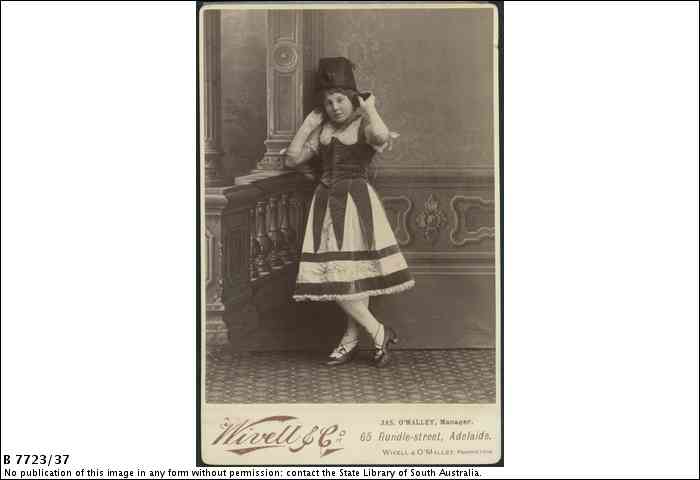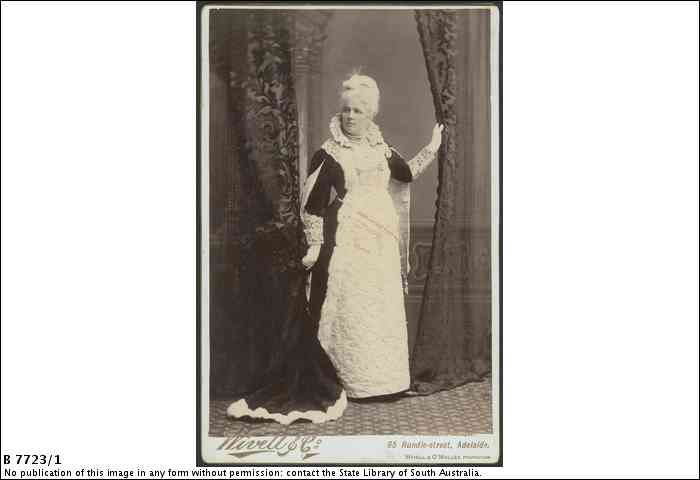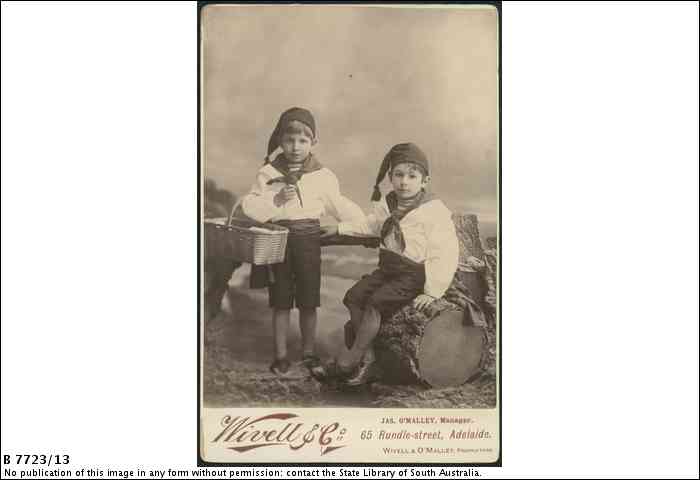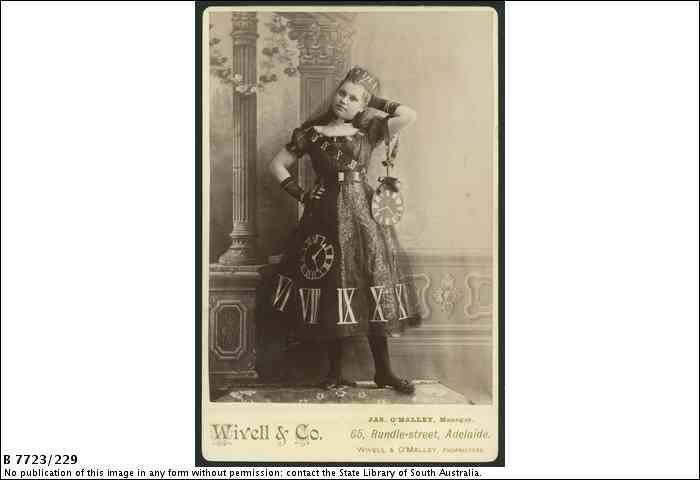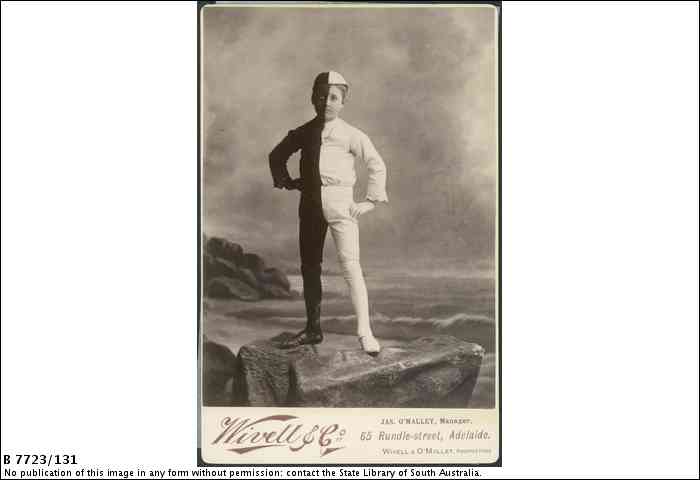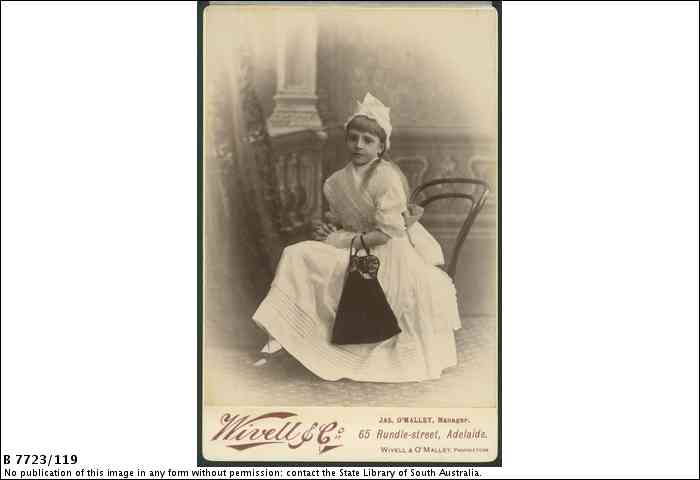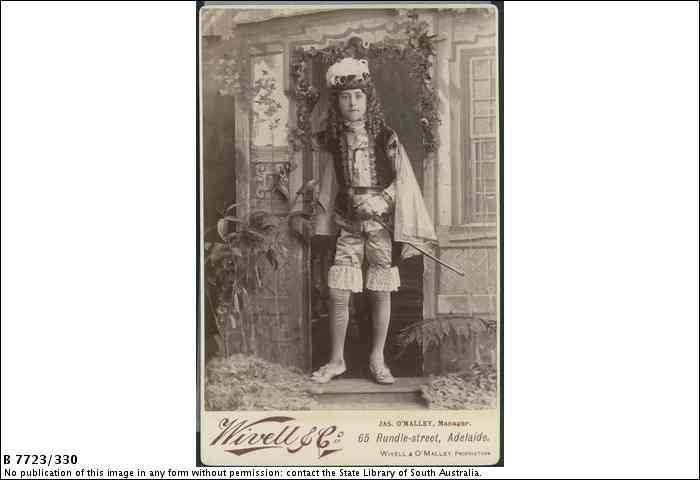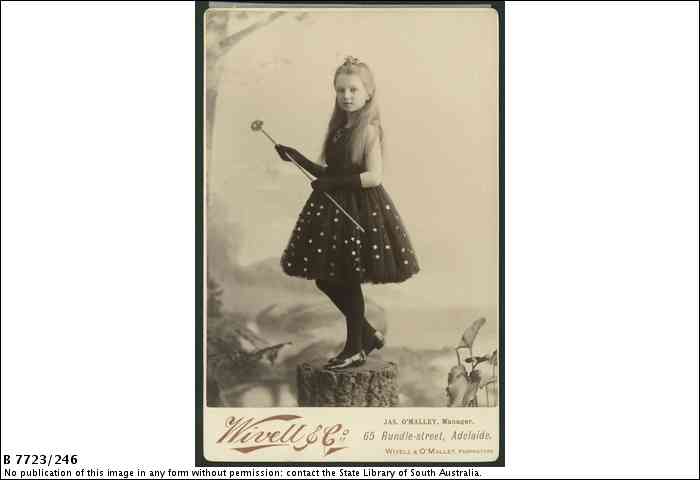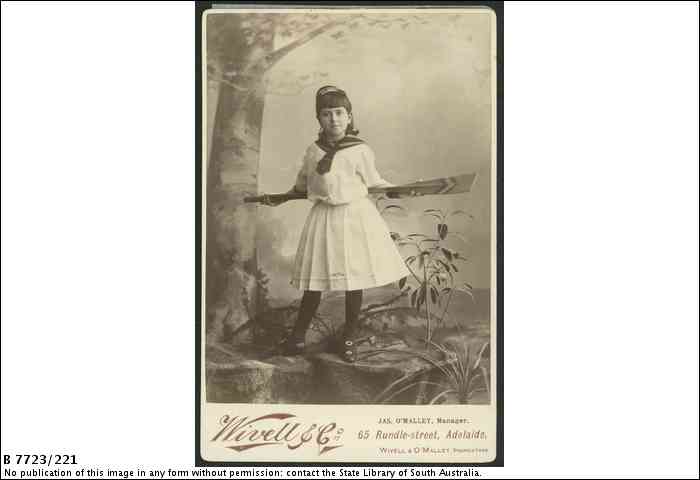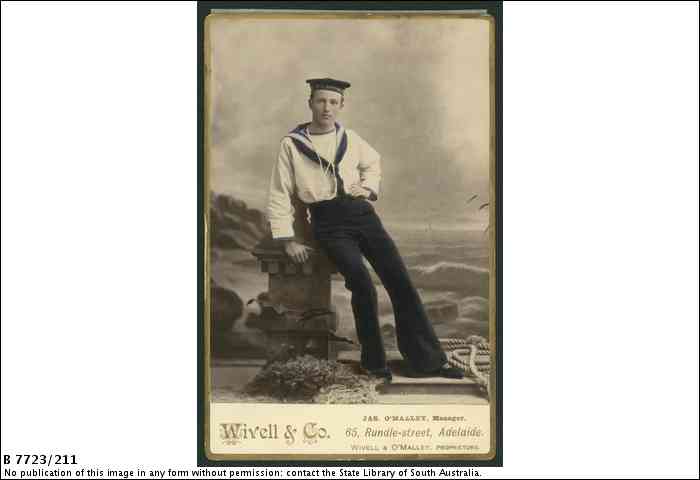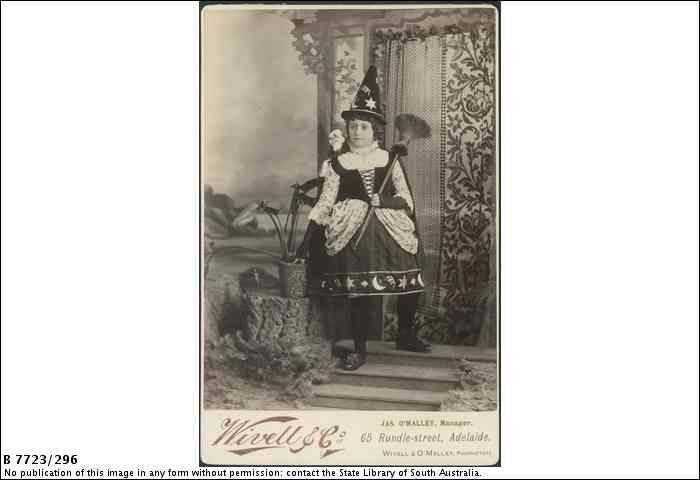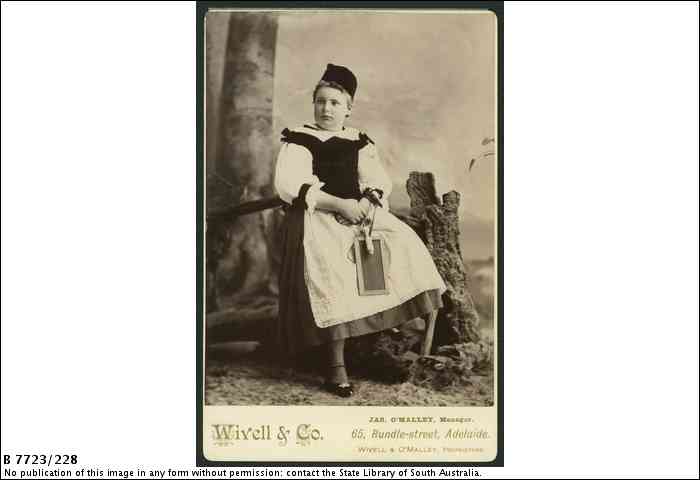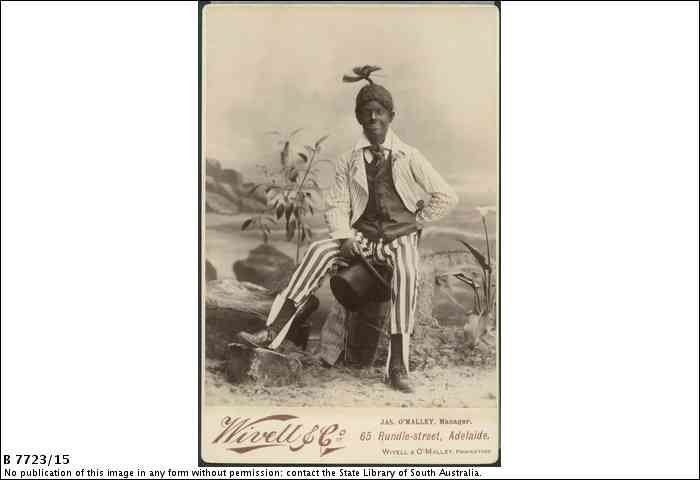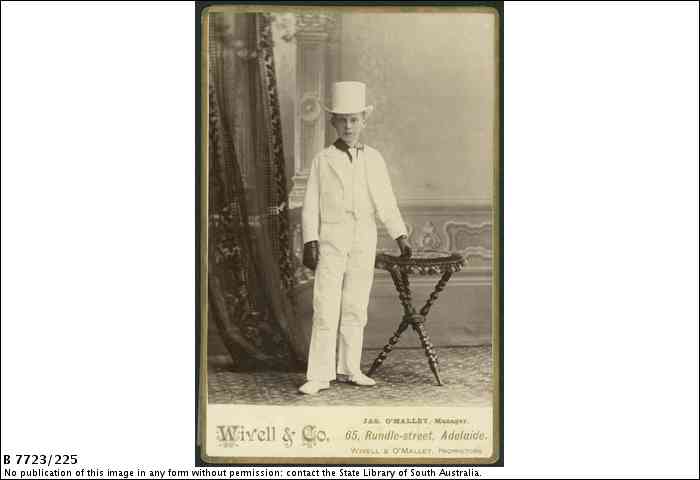Suggest a topic
Suggest a new Did you know? topic

Fancy dress
891 ABC Afternoon Delights at the State Library : 2 August 2005
Carole Whitelock talked with Michael Talbot
|
B 7723/37 - Antonia Bircher: Telephone |
B 7723/1 - Mrs ET Smith: Queen Elizabeth I |
Mrs ET Smith's Juvenile Fancy Dress Ball, 1887
When I was researching the page on telephone exchanges I came across a photograph in the State Library's pictorial collection, dated 1887 and described as 'Antonia Bircher aged 10 years old, dressed as a telephone'. Looking a bit further it turned out to be one of a collection of 387 photos of costumes worn at a Mayoral fancy dress ball for children. I was curious and wanted to know more about the event.
Newspaper coverage
In researching an event like this there are a number of approaches. I was able to locate newspaper coverage in the main Adelaide dailies. The Lady Mayoress of Adelaide, Mrs ET Smith held an elaborate children's fancy dress ball at the Town Hall on 22 September 1887.
Both The Advertiser (23 September 1887, pp. 5-6) and the Register (24 September 1887, p. 6) gave very detailed coverage - more than a broadsheet column to describe the event, followed by a list of most of the children attending and their costumes.
Some 800 'young folk between the ages of 7 and 17' were invited, upwards of 700 attended and over 600 'furnished their cards' and were listed in the newspapers.
Diary entries
People attending might have left a record. For example Samuel Way, the Chief Justice, was reported in the newspaper as being one of the official party. The State Library holds his diaries but his entry for 22 September does not add a great deal: 'To the Mayoress' children's fancy dress ball at 8 pm. Brought home Mrs Makin & her four boys at midnight. Children shewed a great variety of dress. I took Mrs Haigh into supper.' (PRG 30/1/1887)
Weighing the evidence
Historical research is frequently a matter of weighing evidence to see which source is more believable than another. The photographs themselves were labelled, and both the Advertiser and Register published lists of children and their characters based on information handed in on the night. While there is considerable overlap between the lists there are differences. Depending on the newspaper, Master Edgar Sabine was dressed as Tuck or Turk; the photograph shows him in Turkish costume. Fred Stuart or Stewart, costumed as Rome or Romeo, appears to be the latter in his photograph A few people were missed by one or other list. Spelling of names and initials varied between the lists.
The fancy dress ball
|
B 7723/13 - A and R Andrews: Fisher Boys |
B 7723/229 - A May: Clock |
B 7723/131 - Leslie Gardner: Eclipse |
Costuming was not a matter of just scrounging through the dress-up box. The Register commented on 'the uniform richness of the costumes, none of which were paltry or tawdry, and the great majority must have cost a considerable sum'. The Register commented on the 'impetus given to business in the city' by these heavy demands on 'the skill, ingenuity, and resources of local costumiers by fond parents anxious to do justice to the charms of their children'.
The weather on the evening of the 23rd was unfavourable 'rather heavy showers of rain fell just about the time when parents must have been preparing to sally forth with their young folk, but as the occasion was one for which carriages and cabs are necessary, whatever the weather, the rain did not matter.'
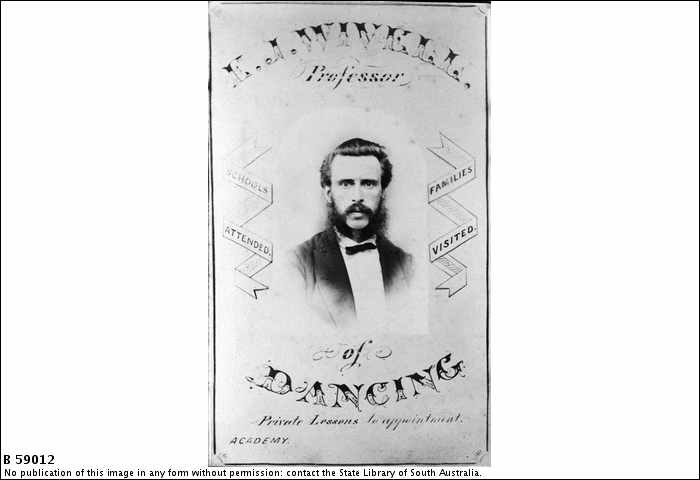 |
|
|
B 59012 - Professor Wivell, 1870 |
A crowd of onlookers speculated about the costumes as the children entered the Town Hall. 'Amongst the most elegant of the dresses were Grecian goddesses, shepherdesses of the Watteau pattern, fantastic fairies, pages in silk and velvet, Orientals, and fanciful conceptions emblematic of something or other associated with the good old days or modern times, according to the ideas of the costumiers.' Mrs Smith attended in the costume of Elizabeth I.
'Each of the children on entering, was taken in charge by an usher and presented to the Mayor and Mayoress, who occupied the dais.' The child's name and character was formally announced.
The opening dance for the evening was a polonaise. EJ Wivell - self-styled Professor of Dancing and author of The ball room companion and pupil's self-help and The six square dances, or, fashionable quadrilles was the master of ceremonies. He 'quickly marshalled the miniature battalion of dancers. Punctually to time Miss Lindstrom's string band played the opening bars of the polonaise. Another moment and the first figure was being gone through. The effect was picturesque, brilliant, and striking.' Miss Lindstrom's string band was in fact the 'Premier String Band of twelve performers'.
Entertainment at the ball
When the polonaise came to an end the band played the opening bars of the "Pinafore" lancers, and sets were formed all over the hall, Mr Wivell being assisted in this task by a number of ladies and gentlemen. The first set was formed as follows: - His Excellency the Governor and Mrs Smith, the Chief Justice and Mrs Haigh, the Mayor and Mrs Meecham, the Hon. JC Bray and Mrs GH Dean, Mr EP Lamprey and Mrs Peterswald, Captain Meecham and Miss Peterswald, Mr RA Stock and Miss Spicer, Captain Dean and Miss Cavanagh. The other dances were - Polka, waltz, schottische, polka, quadrille, waltz, Highland schottische, waltz, lancers, polka, mazurka, waltz, schottische, "Sir Roger de Coverley." The programme was completed in good time, but from shortly after 11 o'clock anxious parents commenced to gather their bairns together, and the hall was gradually cleared. Soon after midnight the room presented a deserted appearance, and the ball was at an end.
Dancing was not the only entertainment - there was an amateur Christy Minstrel entertainment by four players, someone performed conjuring tricks, and a number of children performed hornpipes and jigs.
Messrs FD Beach and Co of Hindley Street and Adelaide Arcade were the caterers, providing tea, coffee and cakes throughout the evening in the supper room. After 10pm a supper was served in the banqueting hall. A table tables were lined up along the length of the room, with another across the head of the hall for the Governor, Chief Justice, Mayor, Mayoress and other adult guests.
The evening was generally held to be a great success. Planning for the event included arrangements for a special late train to Glenelg so children living there would not have to leave early.
The list of over 600 children 'who furnished their cards' is fascinating as a picture of the names popular at the time, and the kinds of characters presented by their costume.
|
B 7723/119 - Addie Fletcher: Kate Greenaway |
B 7723/330 - Walter Stuart: Cavalier to James II |
B 7723/246 - Violet Moulden: Night |
Fashion in names
Names wax and wane in popularity. The Advertiser last Saturday presented the top names for last year and commented that many were 'old-fashioned' and South Australian parents have tended to opt for names popular early last century.
The most common names listed for last year were not the most common in 1887: Emily (2), Charlotte (0), Ella (2), Jessica (3 Jessie), Chloe (0), Jack (5), Joshua (0), Lachlan (0), Ethan (0) and Thomas (3 Tom).
The year I was born Michael was near the top of the list and at school I was in classes with up to six Michaels. Among the 600 names of those attending the fancy dress ball there was not a single Michael.
Among the names less heard today there were plenty of girls called Gertie, Bessie and Nellie and boys named Ernest. As always there were the more exotic names as well: Almeric, Berkley, Denizel, Fairinchirst, King, Mordaunt, Wyckliffe among the boys and Arundell and Caitloch for the girls.
Costumes
Themes for costumes ran the full gamut from Adelaide Rowing Club to Zouave.
|
B 7723/221 - Minnie Mackin: |
B 7723/211 - Harvey Lovely: |
B 7723/296 - Nellie Sanderson: |
Children's storybook and nursery rhyme characters were popular: Little Boy Blue, Mary, Mary, Quite Contrary, the Knave, King and Queen of Hearts, Miss Muffet, Red Riding hood and the Snow Queen.
The time of day, such as Dawn or Night, and the seasons were represented.
Royalty and the nobility formed a large category: whether generically as pages; from the stage with characters like Sir Joseph Porter from HMS Pinafore; or specific characters from history such as Mary, Daughter of Charles I of England. Sporting costume included rowers, hunters, cricketers, and tennis players. Several of the military characters were quite specific about their costumes: Office of Bengal Lancers in mess dress; Officer HMR in undress uniform. While the naval and military characters were principally male, there were a few daughters of the regiment or vivandieres.
Theatrical characters give a picture of what was popular from the time. Gilbert and Sullivan, other operas like the Barber of Seville, and plays by Shakespeare or Sheridan are sources we would be familiar with, but others drew from sources popular then but not much seen today. Struck oil was a play produced many times in Australia by JC Williamson, and one girl went as Lizzie Stofel the main female character. Old Bob Ridley was a character from an American song, published in various forms including Minstrel Songs, Old and New (1883).
Some characters stand out for their imaginativeness. There were seven conventional Eton schoolboys, but Etonian negative dressed completely in white rather than the black uniform.
|
B 7723/228 - Jane EM Marshall: Lizzie Stofel |
B 7723/15 - Edward Andrews: Old Bob Ridley |
B 7723/225 - Jack Makin: Etonian Negative |
Sources
- 'Mrs. E.T. Smith's juvenile fancy dress ball', Advertiser, 24 September 1887, pp. 5-6
- 'Juvenile fancy dress ball', Register, 24 September 1887, p. 6
- Sir Samuel Way, Diary, 22 September 1887, PRG 30/1
- Photographs in the State Library catalogue held as Children's Fancy Dress Ball, 1887
More Afternoon Delights
ABC Afternoon Delights at the State Library was a series in which Carole Whitelock talked with Michael Talbot from the State Library about South Australian topics, illustrated by items from the Library's collections. View the associated SA Memory page for each topic.


